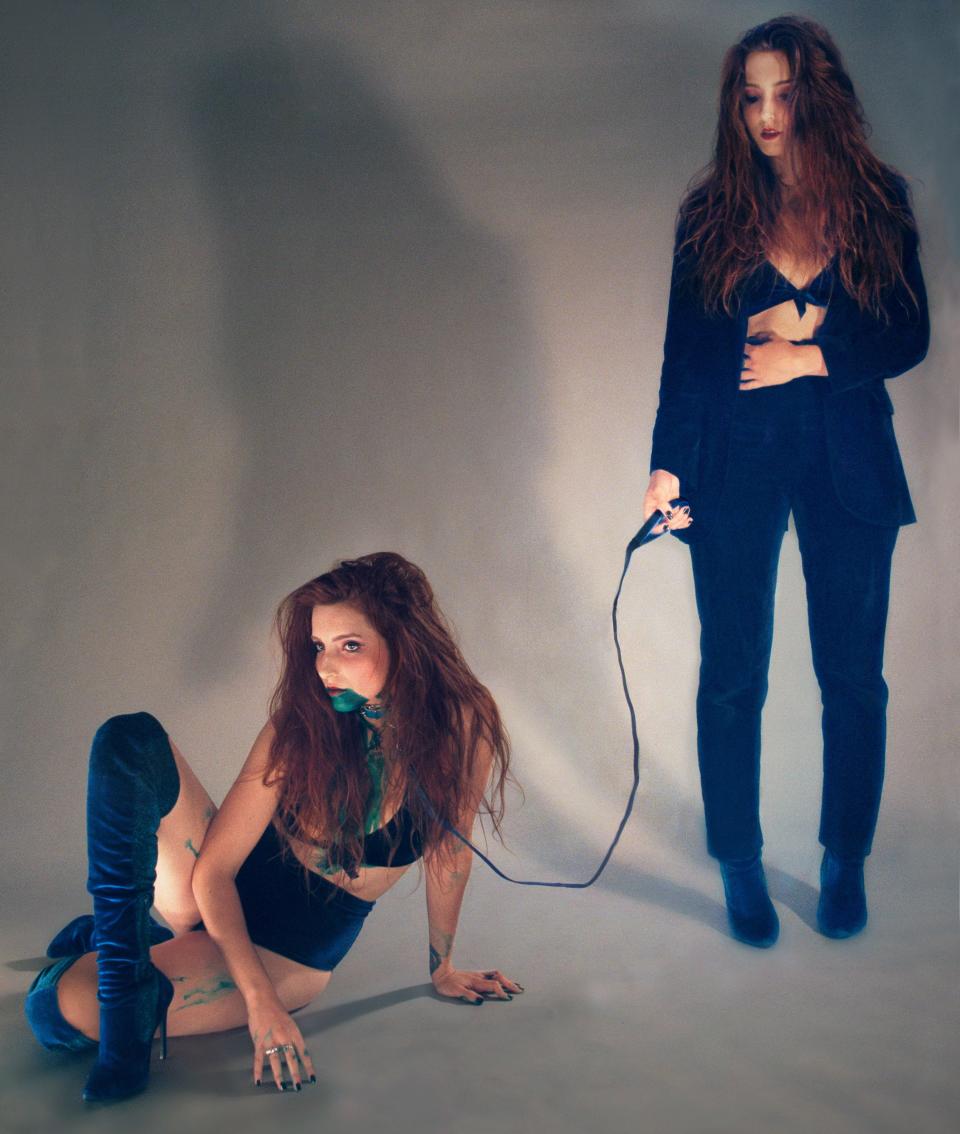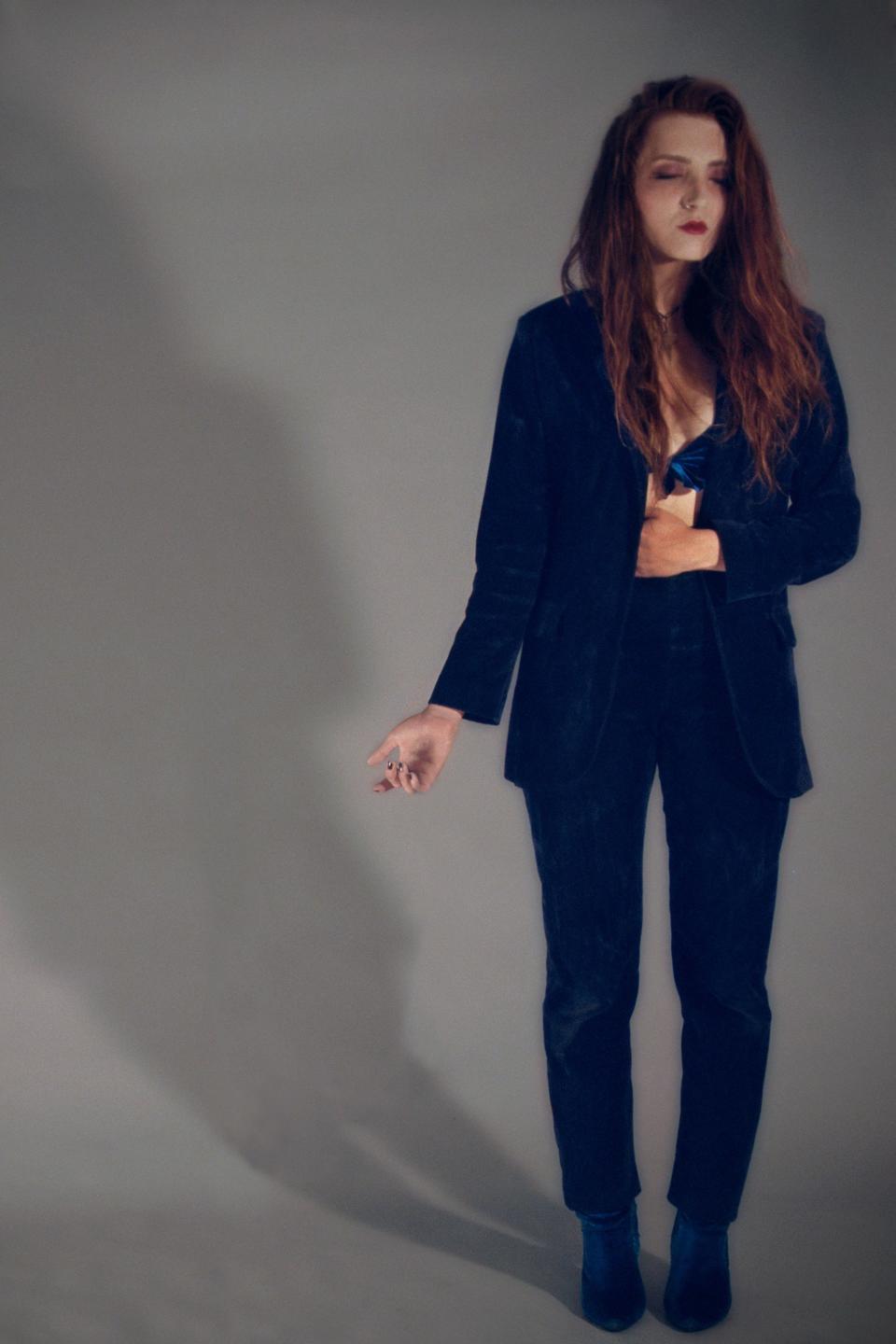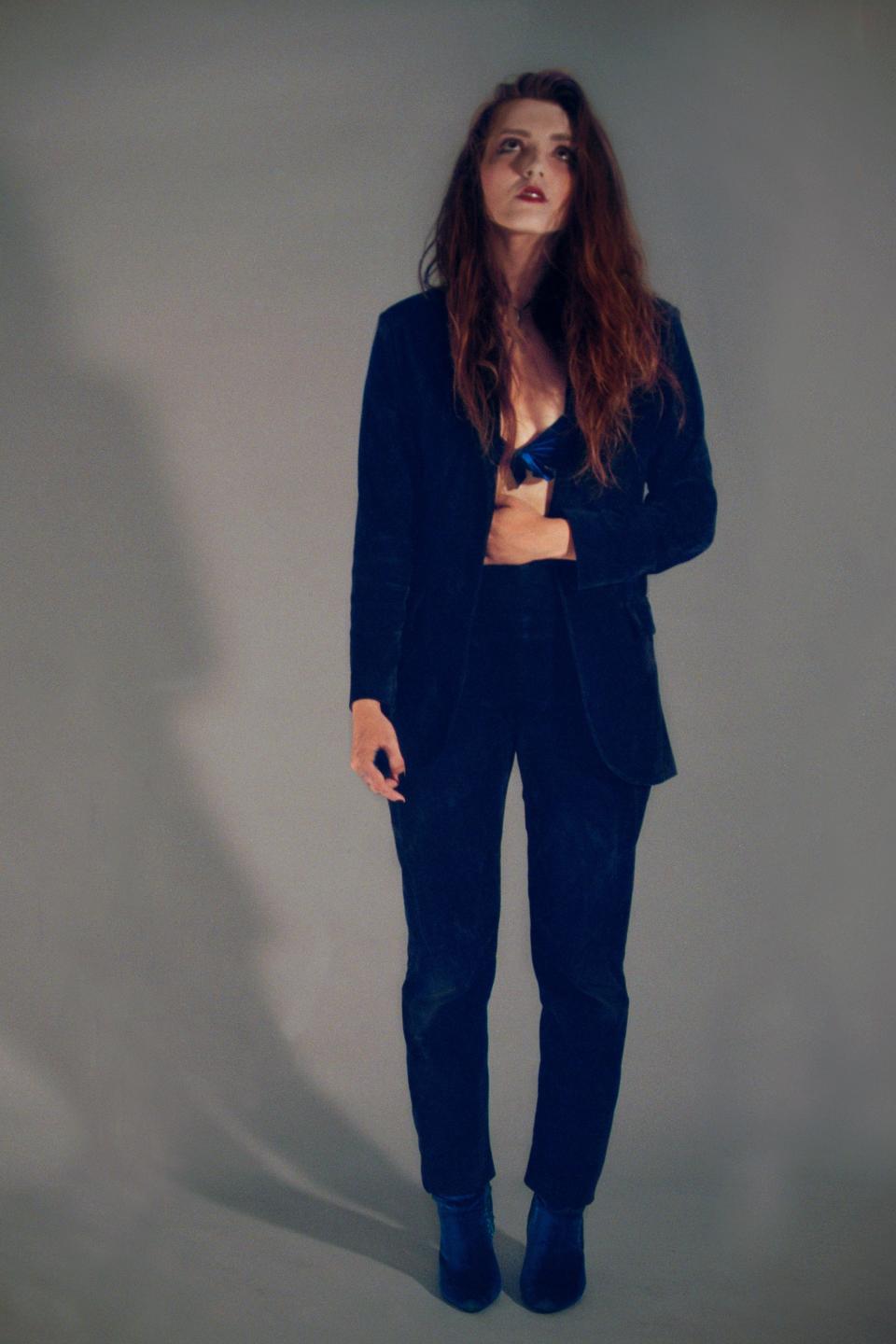Meet the Musical Polymath From Brooklyn Who Wants to Eat Her Favorite Suit
“I dunno if you saw my last email, but I woke up with a hankering to hit Odessa,” Haley Dahl texts me about two hours before we meet. Our initial plan was to go to a cactus store on Essex Street on the Lower East Side that I’ve been meaning to check out, but as this flash of green from my iPhone 6 stares out at me, I start thinking about how I am now desperately jonesing to eat pierogies, or at least something carb-heavy and drenched in grease, at the tiny Ukrainian diner in the East Village. I respond immediately: “Hell yes, very down.”
Dahl is the 24-year-old frontwoman, bandleader, and conductor of the Brooklyn-based 11-piece avant-rock act called Sloppy Jane. She’s from New York originally, but spent most of her childhood and all of her adolescence living in Los Angeles. Dahl formed the prototype of Sloppy Jane at the age of 15, aiming to make something that sounded like Marilyn Manson or Hole (during our chat, Dahl refers to Courtney Love as an “opera star”). She got a few of her friends together and began cutting her teeth playing gigs at shitty Sunset Strip shows. Instead of going to college, she decided to focus on her music; then, to make money and process some intense feelings, Dahl began dancing at a strip club. During her time at the club, she reimagined her personal style, as well as her identity as a performer—and so the current iteration of Sloppy Jane was born.
As of two years ago, Dahl is back in New York, likely for good. The punk three-piece band of yore has since been replaced with a more elaborate setup. At the Sloppy Jane show I went to back in April—during Dahl’s month-long residency at Baby’s All Right in Williamsburg, Brooklyn—it felt like there were a million people onstage, including, but not limited to, multiple backup vocalists, a string section, and two separate percussionists. Watching Dahl is what I imagine it must have been like to watch Captain Beefheart perform Trout Mask Replica—or, indeed, any of the L.A. weirdos from Frank Zappa to Harry Nilsson play during the halcyon days of the ’60s and ’70s. This is to say that Sloppy Jane shows do not feel of this era, and watching Dahl onstage is one of the weirdest and best nights out you can have in New York.
It’s something Dahl is intensely aware of; she is, after all, a performer in every sense of the word. Dahl constantly thinks about her craft and is confident in her vision and her abilities. She thrives within the constraints of her monastic lifestyle, but is also happy to dabble in controlled chaos. Her art is boundless and multidisciplinary; when we meet up at Odessa, she tells me as much. It’s a Saturday afternoon, and the place is pretty much empty. We sit in a booth toward the front of the restaurant. Dahl is wearing smoky eye shadow and a very opulent dark purple top, and I’m equally overdressed. We are two women in our early twenties who stick out like sore thumbs in the somber luncheonette. It feels like a match made in heaven.

What did you want your music to sound like when you were first starting?
I wanted to make music that sounded like Hole and Marilyn Manson, then I got really into some of the weirder Beach Boys stuff. There was a big moment for me when my boyfriend in high school made this CD of Roy Orbison’s greatest hits, and I listened to it after we broke up, when I was in high school. Then I started working in a strip club, where I dealt with a lot of really weird feelings and would listen to the Roy Orbison CD to and from the club every single day to remind myself that someone had loved me before. I listened to it all the time, and it started to deteriorate at the same pace as my mental fabric at the time. During the vocal climax of the song “Only the Lonely,” the CD would fall into complete digital distortion for, like, 10 minutes, and then it would get louder and louder and louder, and then all of a sudden, would go straight back into it. My favorite piece of music of all time is my scratched Roy Orbison CD, and that’s, like, my sole influence. I just want to make that music.
When did you start making music, and what type of scene were you involved in?
I started Sloppy Jane when I was 15; it was just a punk band. It was mostly me and my friend Imogen, who was the drummer, then we had a rotating lineup aside from that. We played a bunch of horrible Sunset Strip shows, like [at] Whisky a Go Go. I wasn’t cool, I was goth. I went to the Smell, regular L.A. punk spots. I am not punk. I tried really hard, but I think deep down everyone could tell that. I think some of my most important relationships in L.A. were with Phoebe Bridgers, who was in the band for a long time. She was the bass player, I knew her from childhood, and then we were best friends in high school. We actually just toured with [Bridgers’s project with Conor Oberst] Better Oblivion Community Center, which was a lot of fun. So Phoebe was in [Sloppy Jane], and she’s an important friend from L.A. I feel like a lot of people who were in Sloppy Jane are the people who are still my friends, like my friend Ember.
I want to hear more about the stuff you’re doing live, which is extremely cohesive. It sounds like one song for the entire duration of your set. When you’re recording an album, how do you replicate that? Do you see your albums as a collection of songs, or are you seeing it as one giant thing?
When I write records—and I did this for Willow and I’m also doing it for our next one—the thing that usually starts the writing process for me is an idea, or a story. The way that I write begins by putting an arc up on my wall with index cards, or I’ll draw on the wall. There’s usually a track list before I start writing, and there will be this song that sounds like this [gestures], and this one with these themes, and this one is going to make this big arc. It gives me all this homework to do. Every single piece changes a million times.
You have a really exciting performance style. How do you get yourself into a mindset in which you command the stage in the way that you do and be able to conduct your bandmates while also dancing?
The dancing and the stuff that I do onstage is also conducting my bandmates. It’s cool that it all serves the same function, which is both to communicate to my band what is happening and to communicate to the audience what the band is doing. We played places with bad sound for so long. A lot of what we did wouldn’t come across correctly, so having a very animated and percussive stage presence helps people’s eyes register what they maybe can’t hear.
I want to talk to you about your relationship to style in your performances.
I’ve thought a lot about the stuff that I wear on stage and how it has a lot to do with the character work. Everything I do onstage starts out as a personal catharsis and becomes part of a permanent cartoon character. When I first started performing stuff, it was in relation to the strip club, and I had a punk band that was named Sloppy Jane, but they were very different. I had a need to take off all of my clothes in front of people and freak out and throw myself against the floor, which is a very on-the-nose reaction to working at a strip club. It started out as this honest thing. When I started performing stuff from Willow, I’d wear stuff from the club: the same shoes, tights, and actual artifacts from [that time period] to let this person who still lives inside of me express herself. Now, I have an outfit that is actually worn at the club. I wear this fancy blue velvet suit, and I don’t get fully nude anymore. I also wear these velvet shoes that you could never actually wear at a strip club, because they’re not for dancing. [Style] is not my emotional landscape anymore. For an entire year while I was writing the new record, I went through this weird, intense time that’s hard to explain. When I first moved here, I had a really big, heartbreak-y breakdown, [during which] I found this oversize black suit hanging on a gate, and I put it on. I was crying and yelling at someone, and was like, “I’m going to wear this until it rots off my body!” I wore it for an entire year without washing it.
When you were performing? Or all the time?
All the time. Constantly. For an entire year. It got so fucking disgusting and so horrible. I stopped wearing it after a year because it stopped feeling like I needed to wear it. My tantrum, in a way, was over. Now I wear a fancier suit that just kind of represents it, without wearing the real thing that smells like hell. I still have it, although I stopped wearing it before it rotted off my body, which was the deal. The one caveat that I gave myself is that if it didn’t rot off my body, then I would one day have to eat it. It’s in my closet, so someday I will have to eat it. We’re recording our next album in a cave, and I think once we finish the recording, I’ll go back to the cave by myself and eat the suit in the dark, then I’ll probably have to go to the hospital [laughs].


What does your approach to style look like right now?
I always like wearing suits. I’m into looking sharp. I like looking a little bit divorced. I have these big sunglasses that look divorced. I hate dressing for summer because you can’t wear anything nice. I like wearing silk shorts and an open robe around. That’s the only summer style that I deem acceptable: ’70s drug-dealer-chic apparel. Other than that, I mostly just wear suits. I’ve fallen down the hole of only having stuff that is dry-clean only. It’s horrible. I either stink or spend a bunch of money. I always buy stuff that is really cheap, and then I’m like, I just spent more to clean it than I did to buy it. Sometimes [I find my clothing in] the trash. I usually do a little loop in the neighborhood at the beginning and end of the month, when people are throwing stuff out. Especially in Williamsburg, where people have nice stuff. [I’ll also check out] my mom’s basement, and sometimes thrift stores. I do more thrift-store shopping when I’m in L.A. I feel like in New York, I usually don’t find that much stuff I like in thrift stores. There isn’t a good woman’s suit game in thrift stores here for some reason. When I’m on tour, we go to every Goodwill that exists, and the bus slowly fills with unnecessary coats. I really like melodrama, though. I wore a suit for an entire year so it would rot off my body. I always feel like I want to look like some kind of spectacle that’s decaying, you know? I love the idea of the aging Hollywood starlet. She’s important to everyone, especially to herself.
You’re recording an album in a cave, so let’s talk about that. What made you arrive at the decision to record in a cave? Where even is the cave?
The cave is in West Virginia, and I decided to [record there] for a lot of reasons. I decided to do it the same day that I put on my suit. It was all one big tantrum where I was like, [begins to fake cry] ‘My heart is bleeding everywhere, and I’m going to wear this suit until it rots off my body and I’m going to drag a piano into a cave.’ Just, you know, these big declarations about being upset. For the record, nothing actually happened that made me do that. I came out of a period of being very emotionally detached, and then all at once there was a big avalanche of everything that had ever hurt my feelings. I just freaked out. Then I read about this cave in Virginia that is actually not the cave where we’re recording. In the ’50s, a man built an organ that plays the stalagmites using mallets that are triggered when you play it. I heard a recording and started sobbing, and was like, ‘I need to make something where they’ll let me play this organ,’ and that was the initial idea. I was writing something so that they’d let me play. And then, of course, I wrote everything and planned the whole project, and I reached out to them and they were like, ‘No, you can’t use it,’ and I was like, ‘Fine,’ and now I’m using a different cave.
Do you enjoy giving yourself room to meander?
I live a very controlled life. I wake up every morning at, like, six, and then I go and drink coffee and sit with my thoughts, then I do pilates, and then I go to the practice space and work on music. I started a new thing where I don’t look at the internet until the afternoon, which has been helping my anxiety a lot. I used to wake up and immediately hit my email like a businessman, which was starting to corrode my ability to think. So that’s what I do. But I also love the adventure of doing insane shit, so I feel like the way I balance everything is as a control freak. I structure my projects in a way where I make adventure a necessary element, where I will have to do something crazy to make the art that I want to make. But I’m not a meanderer—I don’t drink and I’m celibate—I’m very much a man of the cloth. Except that I do have specific months when I do insane stuff.
Originally Appeared on Vogue

